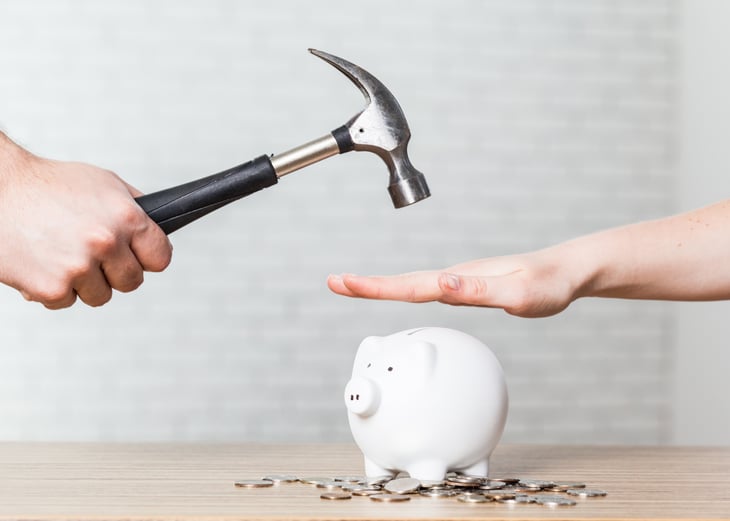
Editor's Note: This story originally appeared on The Penny Hoarder.
Unexpected emergencies — like when your tire blows out on the highway or you fracture your ankle on vacation — can be really stressful events.
An emergency fund is that safety net you can fall back on when the unexpected happens. Because you don’t often anticipate the worst-case scenario happening at any given moment, these unplanned events can steamroll your financial standing. That is, if you don’t have an emergency fund in place.
It isn’t a credit card that you can swipe or a family member you can borrow money from. It’s a stash of cash set aside (preferably in a high-yield savings account or money market account) that you can easily access when needed.
Emergency funds reduce the stress you’ll feel during financial emergencies, like if your pet needs an urgent surgery or you lose your job. Without emergency savings, you might wind up spending the money you need for your monthly bills, sinking into credit card debt or taking out a personal loan when unexpected financial emergencies occur.
Having an emergency fund should be among your top financial goals if you don’t currently have one. Follow these steps to get started building an emergency fund today, so you can handle your next unexpected predicament without maxing out credit cards, taking out a loan or tapping into your home equity.
1. Determine How Much Money You Need Saved for Emergencies

The general rule of thumb touted by many personal finance professionals is to have three to six months’ worth of expenses stored up in your emergency fund.
That doesn’t necessarily mean you need a minimum of triple your monthly household income. But ideally, you’d have at least three times the amount of money it takes to keep your household running for a month.
Look at your budget — or the past few months’ worth of bank statements — to figure out the amount of money it takes for you to live. This doesn’t include what you spend dining out or on clothes or on cable. Those things can be easily eliminated if you had to drop down to a bare-bones budget after a job loss.
You don’t need a fancy emergency fund calculator to determine the amount you should have for your emergency savings. Simply take the total of your monthly essential expenses and multiply it by 3. If you’re able to save for six months instead of three, even better.
If it feels intimidating to try to save that much, start by breaking your savings goal into smaller chunks. Focus on saving $500 and build from there to eventually reach your emergency fund goal.
You’ll hear some financial experts, like Dave Ramsey, talk about having an emergency fund with just $1,000. (Ramsey’s famous money management plan — known as “baby steps” — does urge followers to save three to six months of living expenses, but not until after paying off all non-mortgage debt.)
However, keep in mind that your emergency fund is all about giving you peace of mind that you’d be able to weather a crisis and cover unexpected expenses. Accredited Financial Counselor Kumiko Love told The Penny Hoarder she tried Dave Ramsey’s plan but didn’t stick to it because as a single mom she thought $1,000 wouldn’t be enough to get through a true emergency.
“I was up at night worried that I didn’t have enough for safety in my emergency fund,” Love said.
Also, consider that if your car insurance deductible is $1,000, and you got into a serious accident, you wouldn’t have enough money saved to cover car repairs plus medical expenses and any other costs.
Though three to six months of expenses is the standard, your goal for your emergency fund may vary depending on your situation. If you’re the sole breadwinner of your family or you work in a field where it’d be tough to quickly get another job in the event of a layoff, you might want to save up more than six months of living expenses.
2. Figure Out Where You’ll Keep Your Emergency Fund

It’s important to keep your emergency savings fund liquid and easy to access. Avoid locking your money in a savings vehicle where you’d encounter penalty fees by withdrawing it in an emergency, such as a 401(k) account or a five-year certificate of deposit (CD). While investing your savings could help it grow, you don’t want to risk losing your emergency funds.
Michael Gerstman of Gerstman Financial Group recommends you keep your emergency fund in a no-risk account, like an FDIC-insured savings account or money market account.
A high-yield savings account typically has a higher interest rate than regular savings accounts. So do money market accounts
Stashing your cash in a checking account is another option, though most won’t earn you as much interest.
Make sure you store your emergency fund in an account where you won’t be tempted to spend the money. Consider online savings accounts or a bank account without a debit card if you feel you might be enticed to make unnecessary withdrawals. Putting your savings in a different bank or credit union than where your main checking account is will add another layer of separation.
3. Find Ways To Add to Your Emergency Fund

A mixture of regular savings contributions and lump-sum deposits will build the balance quickly.
Have your employer split your direct deposit so a portion of each paycheck goes to your emergency fund, or set up automatic transfers to your savings account after each payday. When you don’t see the money in your main checking account, you won’t be tempted to spend it.
If your budget is tight, you could cut your spending by switching over to the cash envelope system, canceling monthly subscriptions, joining a Buy Nothing group or switching to less expensive service providers. Or you could increase your income by taking on a side hustle or working a second, part-time job.
You can also increase the amount of money in your emergency savings account by depositing any extra cash you receive from one-time windfalls. Sell items around your house that you don’t use or could part with. Crash with friends for a week and rent out your home on Airbnb. Transfer work bonuses and your income tax refund over to your rainy day fund before you spend a dime.
4. Know When (and When Not) To Tap Into Your Savings

It’s not enough to know how to start an emergency fund. You must also understand what qualifies as a good reason to take money out — and when you should leave it alone.
It can be tempting to see thousands of dollars in your account, but you should avoid using that cash unless you have unexpected expenses due to true emergencies.
A good rule of thumb is to avoid spending your emergency cash on expenses that can be predicted, like routine car maintenance, a large annual insurance bill or summer camp enrollment. You don’t want to build an emergency fund only to spend that money on expenses you could have prepared for. Set up separate sinking funds for those savings goals instead.
And keep in mind, once you’ve spent money from your emergency fund, you’ll need to replenish it so you’re prepared for the next big thing that comes your way.





Add a Comment
Our Policy: We welcome relevant and respectful comments in order to foster healthy and informative discussions. All other comments may be removed. Comments with links are automatically held for moderation.